|
Cutting
Hatches |
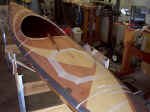 |
The hatch templates have been traced
onto the deck fore and aft, over some masking tape which will help protect
the surface during sawing. I elected to use a small hand saw to cut
out the hatches, because even a small slip or wander would look bad on the
cut lines. The rear hatch is pretty large, the front hatch pretty small -
symmetry! |
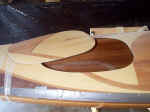 |
Here the aft hatch has been
completely cut out, it took almost an hour counting 2 heat and sweat
breaks. It did turn out perfect, with a very thin kerf. So
thin, in fact, sealing the edges with epoxy might make it oversize!
That is a good problem, however. A 1/2" gap would be a bad problem .
. . |
|
|
|
Hatch Lip Construction (ala
Vaclav) |
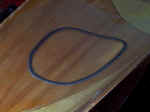 |
Here I've started building the
interior lip for the front hatch, using a "Vaclav" design. Contact
brand clear adhesive paper has been applied over the taped-flush hatch and
surrounding area, and 1/8" thick x 3/8" wide weather-strip has been laid
in place on the inside edge of the cutout. This weather-strip will
form a groove in the layup into which the final, thicker weather-strip
will be laid. The advantage to doing it this way is that the weather-strip
will be compressed tight, but the height of the flush hatch will be
determined by the solid fiberglass lip around the
periphery. |
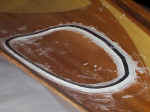 |
Thickened and pigmented epoxy has
been formed into a fillet on either side of the temporary weather strip
plug. This is necessary to allow the subsequent layer of glass to
remain in contact without following severe right angles around the weather
stripping. |
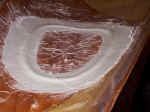 |
Six layers of 6oz glass have been
laid up over the filleted temporary weather-stripping plug. The
epoxy was lightly pigmented white. |
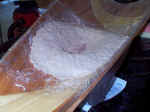 |
Some kitchen plastic wrap has been
laid over the layup, and about 10lbs of wet sand has been patted in place
over the layup. This will help to keep things flat against the
inside deck and the taped-flush hatch |
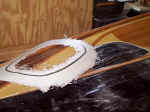 |
Here is the fiberglass layup I made
for the rear hatch, after it was popped from the inside of the deck.
The 1/8" thick black weather stripping will have to be scraped out of the
lip, of course. |
|
|
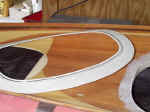 |
The lip as it appears after trimming
and a rough sanding. The temporary weather strip has been scraped
out, the groove needs to be sanded clean. Plenty of glass border
remains to glue to the underdeck. When the kayak has been completed,
thicker weather-stripping will be installed into this groove. and
while it will be compressed, the height of the hatch will be set by the
thin fiberglass lip adjacent to the weather-stripping.
|
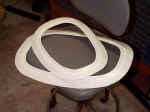 |
The completed hatch lips will now be
set aside until the hull and deck are joined. |
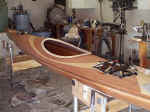 |
After a long delay I'm
back at it. Here the hatch lips are being epoxied in place. The
hatch lips, fabricated in an earlier sequence as fiberglass lay-ups, are
being attached using epoxy mixed with milled glass fibers.
|
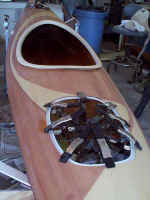 |
This is a close-up of the
clamping needed to flush the lips to the underside of the deck. The
gluing area under the deck was thoroughly sanded before slathering on the
epoxy thickened with milled glass fibers |
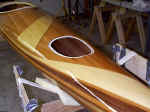 |
Finished fore hatch lip.
White weatherstrip will be installed after the deck and lips are
varnished. |